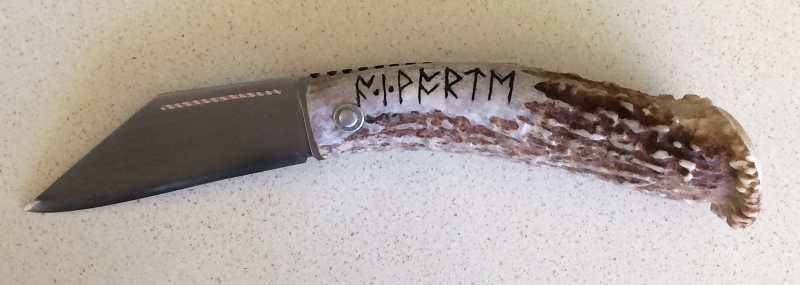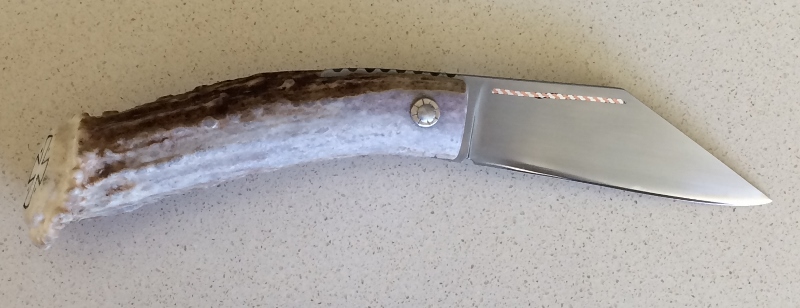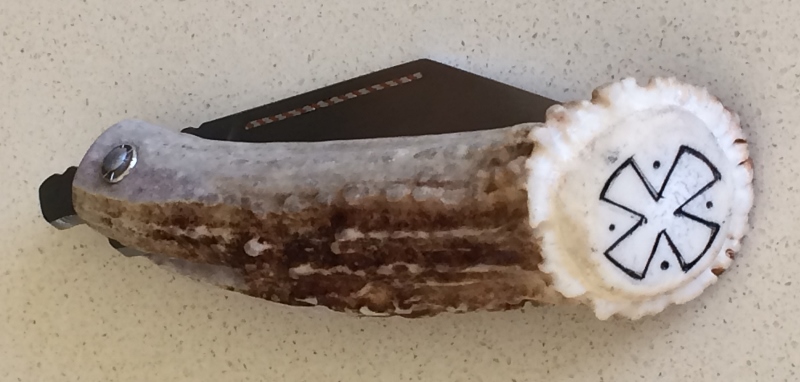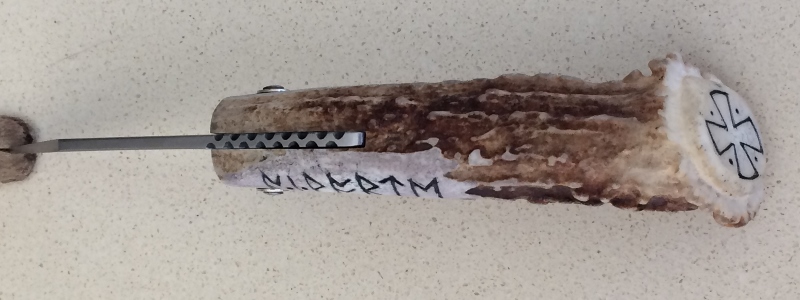| Author |
Message |
|
Alex Indman
|
 Posted: Tue 01 Jan, 2019 8:32 pm Post subject: “Folding Seax” friction folder (DIY project) Posted: Tue 01 Jan, 2019 8:32 pm Post subject: “Folding Seax” friction folder (DIY project) |
 |
|
Here is my latest just completed project. It was done unusually fast, as I stayed home between the holidays and had a lot of time for the hobby work (besides spending quality time with the family, of course).
This is not exactly a reproduction of any historical type, but a combination of two with a bit of fantasy thrown in. I combined a small seax blade (almost exactly same dimensions as the famous Osmund seax from the Museum of London) with a friction folder handle made of deer horn.
I am not sure if friction folders were known in Anglo-Saxon England, but there is definitely one (with a thick one piece wooden handle) dated to XIIIc published in “Knives and Scabbards” by Museum of London.
According to same book (though it intentionally doesn’t cover seaxes), the old broken back seax form still appeared (very rarely) even in post Conquest times, say XIIc. And blade decorations in that period tended to be minimal (like one or two grooves, sometimes with inlay) and applied symmetrically to both sides.
So my imagined story is that some knifesmith in XIIc England decided to use the still remembered ancestral seax blade profile for a folder. But the copious full surface inlays of old seaxes are now out of fashion so he went with the currently acceptable one line inlay on both sides (but of twisted silver and copper wire, as a reference to older decoration techniques). As another reference to old times, he engraved in the handle an inscription in Anglo-Saxon runes (let’s say he consulted a learned monk on spelling).
Anyway, historical justifications aside, it was a very interesting project for me. I tried two new techniques: using deer horn as folder handle, and putting soft metal inlays in a blade. Both worked out pretty well.
There is no sideways play in the blade at all, and just enough friction to hold it open or closed. I can actually manage to open and close it one handed.
Inlay is secure and looks nice with just a couple small hairline gaps (apparently I cut the groove too deep in places). I am thinking of trying a normal fixed blade small seax with much more extensive inlays as a future project.
Blade is 3 ¼” long, 1” at widest point, 1/8” thick. Handle approximately 4 ½” long.”
Made by stock removal from 1095 steel, quenched in oil (I made it a differential quench, leaving back soft), and tempered. Finished to 600 grit, with shaving sharp polished edge (very slightly convex shaped).
Inlay of twisted together 24 gauge fine silver and copper wires was hammered in after the blade was heat treated, but the grooves for it were cut before. Don’t know if this is the right way, but it worked for me (I chose this approach because I was afraid that the back of heat treated blade may end up too hard for cutting grooves).
Handle about 4 ½” long, of deer horn with “crown” forming the butt.
Anglo-Saxon runic inscription says “A.I. (my initials) WORTE (made)”. I didn’t have to go looking for learned monks to find out how to spell it. I just used a book (“Runes”, published by the British Museum).
On the butt I engraved a cross of a shape I saw as part of some Anglo-Saxon runic inscriptions. Since I don’t have any artistic inclination for more complicated designs, it had to be something simple, and since the period was supposed to be relatively late, symbols of pagan origin (like Odin’s knot) were rejected.
An interesting thing that I noticed only after finishing the knife is that it feels more comfortable in left hand (because of how the crown is oriented). Not that it is can’t be used right handed, it is still comfortable enough (I am right handed, BTW).
Small pictures attached, bigger versions can be seen at https://public.fotki.com/aindman/friction-folder-wit/
Alex.
 Attachment: 138.71 KB Attachment: 138.71 KB

 Attachment: 146.8 KB Attachment: 146.8 KB

 Attachment: 149.86 KB Attachment: 149.86 KB

 Attachment: 150.5 KB Attachment: 150.5 KB

 Attachment: 138.2 KB Attachment: 138.2 KB

|
|
  |
 |
William M

|
 Posted: Wed 02 Jan, 2019 2:41 am Post subject: Posted: Wed 02 Jan, 2019 2:41 am Post subject: |
 |
|
Haha, awesome!! I have long thought about making something like this but wasn't too sure on how to make a decent friction fit so it would be ok for legal carry in the UK.
Really nice knife, good job.
|
|
   |
 |
|
J. Scott Moore
|
 Posted: Wed 02 Jan, 2019 12:15 pm Post subject: Posted: Wed 02 Jan, 2019 12:15 pm Post subject: |
 |
|
stunning work! I almost did a similar thing with my last knife!
"Whoever desires peace, let him prepare for war."
-Vegetius
|
|
   |
 |
|
Ryan McLaurin
Location: California Joined: 12 May 2008
Posts: 42
|
 Posted: Wed 02 Jan, 2019 1:33 pm Post subject: Posted: Wed 02 Jan, 2019 1:33 pm Post subject: |
 |
|
|
That's really awesome! You should let it develop some patina for a more antique look. It will be a conversation starter if you decide to EDC it.
|
|
  |
 |
|
Alex Indman
|
 Posted: Thu 03 Jan, 2019 7:00 am Post subject: Posted: Thu 03 Jan, 2019 7:00 am Post subject: |
 |
|
Thanks for the replies, guys!
William, I was also considering this project on and off for a couple of years, having doubts over the fit. But once I bit the bullet and tried, it turned out pretty doable (even with no "professional" equipment). Going slow and careful does it. And this was the first knife of this type I made (I did make one friction folder before, but it was of "modern" handle construction - flat Micarta scales). If you are interested, I can share a couple of tricks I worked out for this project.
Ryan, I actually wanted to patinate the blade originally (for better contrast with inlay), but found that it looked pretty good polished. Maybe I will do it later, some simple patina is easy enough to apply (and remove if I don't like it).
The knife is way too bulky for EDC in a city, though. With this thick handle (especially the "crown" part), it won't comfortably fit in any pants pocket.
I do carry my first friction folder pretty often, as I designed it specifically for EDC (pretty much any locking blade knife is illegal to carry here in NYC, and a knife you carry must not be visible, not even "printing" through the pocket). See it at https://public.fotki.com/aindman/friction-folder/ . But even that one feels a bit thick and heavy sometimes.
BTW, I wonder how people carried their friction folders in the middle ages, and why they needed them at all. AFAIK, there were no pockets as such back then. So what's the point of having a folder if you could just as well carry a small fixed blade on your belt? I guess the only place for a folder in medieval clothes would be in some kind of little bag/purse carried on your belt, along with whatever other miscellaneous small items that people could need daily.
Any thoughts on this subject?
Alex.
|
|
  |
 |
|
|
You cannot post new topics in this forum
You cannot reply to topics in this forum
You cannot edit your posts in this forum
You cannot delete your posts in this forum
You cannot vote in polls in this forum
You cannot attach files in this forum
You can download files in this forum
|
All contents © Copyright 2003-2025 myArmoury.com — All rights reserved
Discussion forums powered by phpBB © The phpBB Group
Switch to the Basic Low-bandwidth Version of the forum
|

